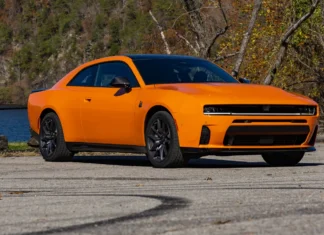
The C7 Chevrolet Corvette Stingray is formidable at 455 horsepower coming from its LT1 6.2-liter engine. The Stingray’s LT1 V8, which is the heart of the sports coupe, represents the most significant redesign in the Chevy Small Block’s 60 year history and has the numbers to prove it. Even with a zero to sixty time of less than four seconds, the C7 Corvette isn’t the fastest from the GM factory. Dare we mention the Corvette Z06 that cranks out 650 horsepower from its supercharged V8?
Power and performance have always been hallmark traits of the Corvette, but this wasn’t always the case. The first Small Block V8 debuted in the Corvette in 1955. It displaced 4.3L (265 cubic inches) and was rated at 195 horsepower, drawing air and fuel through a four-barrel carburetor. Five years later, V8 power helped Corvette secure its first victory at the 24 Hours of Le Mans.

“Horsepower is the most popular metric for sports car performance — both gear heads and enthusiasts want to see power ratings above all else,” explains Mike King of NewGMParts.com. “What’s so fascinating about the Corvette is the way that horsepower quickly rose in the 50s and 60s, dropped off in the 70s, and then dramatically increased in just the last five years,” says King.
The chart, created by NewGMParts.com, shows how 60s era third generation Corvettes reached over 400 horsepower but plummeted below 300 hp in 1972, remaining at this surprisingly low horsepower level until the late 1980s.
From the Corvette’s debut with a slight inline 6 to the 2015 Z06, the chart shows how Corvette horsepower has nearly quadrupled from 1953 to 2015. While 0-60 is a good indicator of how easily a car can merge onto the highway, the great American yardstick of acceleration will always be 1/4-mile elapsed times and the Z06 doesn’t disappoint, claiming a 10.95-second time in the 8-speed automatic with the 7-speed manual clocking a 11.2, both with identical 127 mph trap speeds. Corvette has come a long way, it took a stock 1953 Vette 11 seconds just to hit 60 mph.
Source: Spork Marketing/NewGMParts.com
Have a favorite Corvette generation that speaks volumes to you above all others? Let us know in the comments below.
First Generation – 1953-1962
Revealed in 1953, the first Corvette rolled off the assembly line in Flint, Michigan. All were powered by the three-carb, 150 horsepower Blue Flame inline-six cylinder and two-speed Powerglide transmission. The first small block V8 showed up in the Corvette in 1955 and was backed by a three-speed manual — saying goodbye to the six-cylinder Corvette. In 1957, the V8 was increased to a 283 and ordered to be fuel injected. 1958 saw the first year of the 160-mph speedometer and the engine grew to a 327 in 1962.
Second Generation – 1963-1967
The Z06 was introduced (for the first time) as a special equipment option on the Sting Ray. In 1965, the big block arrives in the form of a 396 cubic inch L78 — increasing to 427 cubic inches in 1966. In 1967, the legendary L88 iron block made its debut. It rated at 430 horsepower but was later found to pump out 500 horsepower in independent testing.
Third Generation – 1968-1982
The Corvette offered a 435 horsepower, 7.0L, 427 cubic inch engine for the C3 debut. In 1970, the 390 horsepower, solid lifter LT1 was introduced — the big block was increased to 454 cubic inches. The LS6 454 was introduced as an option in 1971, and the first generation LT1 is killed off by 1972. 1974 marked the last year for the big block, and by 1975, the Chevy 350 was making only 205 horsepower in the Corvette. Since GM didn’t certify the 350 V8, all California bound Corvettes got a 305 in 1980. Corvette production was paused in 1983 for a rebuilding year.
Fourth Generation – 1984-1996
The C4 started out with a measly 205 horsepower and 290 lb-ft of torque. In 1985, things started to look up slightly with a 230 horsepower 5.7L. In 1987, a Callaway TT option that made 345 horsepower/465 lb-ft of torque was available through some dealerships. The ZR-1 debuted in 1990 with a 5.7L capable of making 375 horsepower — increased to 405 hp in 1993. In 1992, a new LT1 was implanted in the Corvette, this time making 300 horsepower. New for 1996 was the LT4 engine that was rated at 330 horsepower.
Fifth Generation – 1997-2004
The 345-hp LS1, an iconic all aluminum engine, became the backbone of the GM engine family, starting with the Corvette. In 2001, the modern Z06 was introduced with a 385 horsepower LS6 and top speed of 170 mph. The Z06 pushed over the 400 horsepower mark, making 405 horsepower in 2002.
Sixth Generation – 2005-2013
By 2006, the Z06 got a new 7.0L making 505 horsepower and 470 lb-ft of torque. In 2008, the base engine was a new LS3, which made 430 horsepower. A new ZR1 debuted in 2009 with a supercharged 6.2L and top speed over 200 mph.
Seventh Generation – 2014-present
The C7 debuted making 455 horsepower with a 6.2L, new generation LT1. A 2015 year model Z06 showed up making 650 horsepower with a supercharged 6.2L LT4 that delivers the Z06 from 0-60mph in just 2.95 seconds, while the 7-speed manual reaches 60 mph in a very respectable 3.2 seconds.
While 0-60 is a good indicator of how easily a car can merge onto the highway, the great American yardstick of acceleration will always be 1/4-mile elapsed times and team Corvette didn’t disappoint, claiming a 10.95-second time in the 8-speed with the 7-speed manual clocking a 11.2, both with identical 127 mph trap speeds. Corvette has come a long way, it took a stock 1953 Vette 11 seconds just to hit 60mph!
























